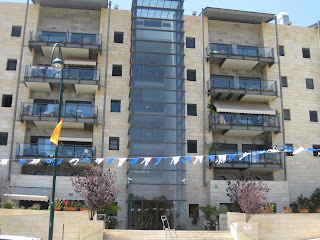On 4 February 1997, two helicopters collided in mid-air above the small settlement She'ar Yashuv in north Israel. All 73 soldiers that were on these helicopters were killed on the spot. One of the helicopters fell on a rental vacation room that was not in use; the other fell on open field near kibbutz Dafna. The day of February 6 was declared an official day of mourning.
We visited the place of the disaster last month on our way to Mt. Hermon (see previous post about the trip to the mountain) - to contemplate the memorial honoring the memory of the 73 soldiers , and pay our respects.
There's a monument at She'ar Yashuv, but the main official memorial was inaugurated eleven(11) years after the crash, near kibbutz Dafna's cemetery.
The memorial site is peaceful and solemn, yet very impressive. Seventy-three(73) beautiful rocks are scattered on a green lawn. There are holes in the rocks that make it possible for the visitor to light a tea candle. On the black edges around a pool are the names of the fallen soldiers written in white - and from the round pool, a narrow stream of water flows towards a large rock covered with plaques; the writing on these plaques tells the story of the deadly collision.
From this rock a narrow path leads to the trees where, according to the news at that time, parts of the helicopter and bodies fell upon. The tree branches bear small stone plaques with the names of the soldiers, photos, and other 'mementos'. This is the "spontaneous " memorial that has been created in the first years after the disaster.
plaques with names on the tree branches
On the southeast edge of the She'ar Yashuv settlement there's the "Forest of the Fallen" with seventy-three (73) trees to remember the 73 victims of the helicopter crash.


























































